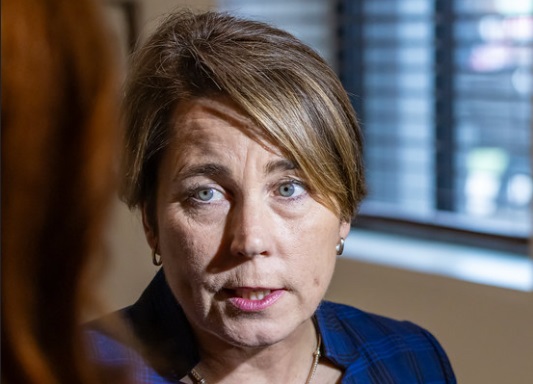Healey-Driscoll Administration announces systemwide changes to lower Massachusetts shelter costs, to file supplemental budget
BostonIn an effort to save expenses and assist more families in locating secure, long-term housing, the Healey-Driscoll Administration today announced plans to make adjustments to the state’s Emergency Assistance (EA) family shelter system. In order to serve more families while lowering the number of shelter units, the Administration says the measures will help control costs, phase out the use of hotels, concentrate resources where they can have the biggest impact, and better meet the immediate needs of individual families. These modifications are in accordance with the Special Commission on Emergency Housing Assistance Programs’ recommendations.
About 7,500 households have remained in the EA system. Every day, up to 40 families sought refuge. About 65 percent of those families are long-term Massachusetts families, and the average has been closer to 15–18 families per day in recent months.
Since November 2023, the administration has assisted over 4,300 shelter inhabitants in finding employment, over 1,550 shelter residents in enrolling in ESOL programs, and over 6,100 shelter residents in obtaining work authorizations. Since August 1, 350 families have successfully left temporary respite centers (TRCs), and over 3,800 families have left shelter thanks to their initiatives in the last year. In addition to exits, investments in services that assist families in avoiding shelter and rapidly reestablishing themselves have resulted in the diversion of over 700 families from EA shelter in the previous year.
The state’s family shelter system has become more and more unsustainable in recent years. Significant steps have been taken to control its expansion, and the effects are evident. According to Governor Maura Healey, the system’s size has stayed constant over the past year, families are no longer dependent on emergency rooms or the airport for refuge, and all shelter locations now have a service provider rather than the National Guard. To ensure that Massachusetts taxpayers are not left footing the bill for this federal issue, more must be done. Our proposed modifications will lower expenses, gradually phase out hotel use, and better serve the requirements of all families.
Lieutenant Governor Kim Driscoll stated, “As Chair of the Special Commission on Emergency Housing Assistance Programs, I heard clearly a consensus regarding making shelter brief, rare, and non-recurring.” To ensure that we no longer have a one-size-fits-all system, our administration is implementing policy adjustments based on the guiding principles established by that bipartisan Commission. Families’ particular needs will be better met, they will be able to find secure homes more rapidly, and the state will save money as a result.
supplying shelter models based on the needs of families
Families will be evaluated based on their risk and needs starting on December 10 and sent to the Bridge Shelter Track or the Rapid Shelter Track in the system. It is anticipated that stays in the Rapid Shelter Track will end in 30 days. Subject to legislative permission, stays in the Bridge Shelter Track are anticipated to cease in six months.
Quick Shelter Track
- The Rapid Shelter Track involves thousands of families who have strengths and needs that position them to rapidly find self-sufficient permanent housing. They will be offered 30-days of intensive support at Temporary Respite Centers to receive assistance with transitioning quickly to stable, permanent housing many with stabilization services available through HomeBASE as well as assistance with and referrals for work authorizations, job placements and English classes.
- These changes will allow families to stay at TRCs longer, increasing the maximum time from five business days to 30 business days, with some allowance for extensions. This shift is responsive to exit data trends and feedback from providers and is more aligned with the amount of time needed to exit to safe housing, especially when leases are involved. Families will not be able to choose between tracks. Families who are given access to intensive services at a TRC will not be eligible for placement in the Bridge Shelter Track.
Bridge Shelter Track
- The Bridge Shelter Track is meant for more high-risk families and those with more complex needs that take longer to resolve to find permanent housing they may be women who have a late-term pregnancies, people with intellectual or developmental disabilities.
- Families in this track would be eligible for up to six months, pending legislative approval. The goal for families in the Bridge Shelter Track is the same as the Rapid Shelter Track help them transition to stable, permanent housing as quickly as possible, as well as connect them with work authorizations, job placements and English classes.
These adjustments will give shelter system services a higher priority based on need and risk. The parents will be more eligible for the Rapid Shelter Track, for instance, if they are able to work, as this will enable them to move into stable accommodation. A family may require more assistance to secure long-term housing and be referred to the Bridge Shelter Track if they have complicated risks or needs, such as a lengthy history of evictions or obstacles to employment.
In addition to being the most costly shelter model, hotels and motels don’t offer the best conditions for long-term housing that can assist families in getting back on their feet. For instance, a lot of hotel rooms are too small for services, which can be alienating and makes it harder for case managers to interact with families. As a result, between fiscal years 2025 and 2026, the administration will gradually phase out shelters in hotels and motels in favor of a more helpful and economical portfolio.
Based on conversations with providers, hotels and motels will be shut down gradually. Prior to scheduled closures, the local community and families will be informed. Before a site closure, providers will work closely with families to facilitate departures into secure and stable homes.
Reducing housing costs and expanding housing supply throughout the state are priorities for the Healey-Driscoll Administration. The administration will be proposing legislation to expand the temporary rental subsidy under the HomeBASE program in order to assist more families in obtaining stable, long-term housing as soon as feasible. Families will be eligible for up to $25,000 in rental assistance annually for two years under these modifications. Right now, the payout is $30,000 spread over two or $45,000 spread over three years.
In order to assist families with one-time expenses to help them leave shelter, the government is also growing its present programs. About 3,800 families—both Massachusetts and immigrant families—have left shelter in the last 12 months, many of them with the help of HomeBASE or other state rehousing aid programs. By assisting families in finding secure, long-term housing—which is more affordable than shelter—these programs lessen dependency on shelter.
In a supplemental budget, the administration will ask for adequate funds for EA to be appropriated to a newly established reserve account, the Family Shelter and Services Reserve, for the balance of Fiscal Year 2025. Instead of affecting programs that are funded by the annual budget, this proposal expects to use reserve cash to meet these costs.
In order to help families and EA providers rehouse more quickly, the supplemental budget will propose to shorten the duration of stay for EA shelter from nine months to six months and modify the extension criteria. This will ultimately help families move to permanency more quickly and enable the system to serve more families.
In order to better reflect current rental market rates, the supplemental budget will also suggest raising the HomeBASE rental allowance from $15,000 per family annually to $25,000. In order to control expectations as we assist more families in finding long-term housing and lessen their need for shelter, it will also suggest capping the benefit at two years.
Additionally, some recent modifications to existing EA-related facilities are being shared by the administration. The Quincy Family Welcome Center will relocate to a new location on Hancock Street in Quincy in December, and the Quincy Clinical and Safety Risk (CSR) assessment site at Eastern Nazarene will close due to the college’s scheduled closure. The present CSR facility in Revere will now support all high-risk families.
The Cambridge Temporary Respite Center is scheduled to close on December 15th. The family are being quickly rehoused at this location by staff members. At one of their current locations in Mattapan, the Immigrant Family Services Institute (IFSI) has also begun providing Family Welcome Center services.
Note: Every piece of content is rigorously reviewed by our team of experienced writers and editors to ensure its accuracy. Our writers use credible sources and adhere to strict fact-checking protocols to verify all claims and data before publication. If an error is identified, we promptly correct it and strive for transparency in all updates, feel free to reach out to us via email. We appreciate your trust and support!

